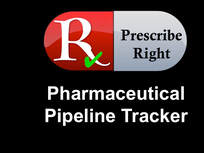|
Three new drugs are in development for the treatment of acute migraine. While many patients receive relief with triptans, not all patients can tolerate a triptan or are helped by a triptan. Clinical trials suggest that triptans relieve migraines in two hours in 16–51% of patients. The number of patients helped is likely higher since patients take a triptan dose after the pain is already moderate to severe, rather than early in the onset of the migraine attack in the trials. The triptans also have a contraindication in patients with cardiovascular disease, peripheral vascular disease, cerebrovascular disease, and uncontrolled hypertension because of the potential for ischemia.
For these reasons new drugs are being developed. The two classes of investigational migraine drugs include gepants (ubrogepant and rimegepant) and lasmiditan (a ditan). Neither class causesvasoconstriction, which removes safety concerns over ischemia. Two Phase III trials have been completed for each drug, but the results have not been published for any of the studies. Lasmiditan(Lilly) is a highly selective 5-HT1 receptor agonist that inhibits central and peripheral neuronal activity without vasoconstriction. Ina 1,856 patienttrial, at 2 hours 59% of lasmiditan patients were pain free and 41% were free of their most bothersome symptoms compared to 43% for pain resolution and 30% for symptom resolution with placebo. In a2,155-patienttrial, 29% of patients treated with lasmiditan 50 mg, 31% with 100 mg and 39% with 200 mg were pain free at two hours compared to 21% with placebo. The most bothersome symptoms at two hours were eliminated in 41% oflasmiditan 50 mgpatients, 44% with 100 mg and 49% with 200 mg compared to 33% with placebo. The other drug class being developed to treat acute migraine attacks are the gepants. Early gepants demonstrated liver enzyme elevation, so hepatic adverse events are continuing to be monitored as the gepants are developed. Each drug has been evaluated in two phase III trials and does not appear to cause hepatotoxicity. Allergan purchased ubrogepant from Merck has continued its development for the treatment of migraine headaches. In a 1,327 patient, trial, at two hours 19% of migraine patients treated with ubrogepant 50 mg and 21% with 100 mg were pain free at two hours and 39% of patients were rid of their most bothersome symptoms with ubrogepant 50 mg and 38% with 100 mg compared to 12% and 29% with placebo. In a 1,355 patient, Phase III trial, the percentage of patients that were pain free at two hours were 21% with ubrogepant 25 mg, 22% with 50 mg and 14.3% with placebo. The most bothersome symptoms at two hours were eliminated in 39% of patients treated with ubrogepant 50 mg compared to 27% with placebo. The lower 25 mg dose of ubrogepant did not reach a statistical difference compared to placebo for freedom of the most bothersome symptoms. Biohaven Pharmaceuticals bought rimegepantfrom BMS and continued its development. In a 1,084 patient, Phase III trial, 19% of patients treated with rimegepant were pain-free and 37% were free of their most bothersome symptoms at two hours compared to 14% and 28% that received placebo. In a 1,072 patient, Phase III trial, 20% of patients treated with rimegepant were pain-free and 38% were free of their most bothersome symptoms at two hours compared to 12% and 25% with placebo. Biohaven Pharmaceuticals is also developing an orally disintegrating tablet (ODT) formulation for rimegepant. Stay current with drugs to treat or prevent migraines and other drugs in the late stages of development with the Prescribe Right Pharmaceutical Pipeline Tracker. Comments are closed.
|
Stay informed, subscribe to the
Prescribe Right Pharmaceutical Pipeline Tracker Latest Tweets from Prescribe Right
Archives
July 2023
|
Services |
Company |
Support |
© COPYRIGHT 2015. ALL RIGHTS RESERVED.
|


 RSS Feed
RSS Feed